The Streamline Era: A Personal View Budd Steinhilber, FIDSA
The Streamline Era: A Personal View
Budd Steinhilber, FIDSA
Recently, Auburn University industrial design educator Bret Smith, IDSA asked me, “What did industrial design look like to you, as the profession emerged in the 1930s and 40s?”
Well, first, I should remind you that during the decade from 1930 to 1940, the country was in the stranglehold of a very severe depression, brought on by high-risk speculation by banks and the subsequent collapse of its financial markets. (We never seem to learn from the past). Despite the Depression (or perhaps because of it), two World’s Fairs were mounted during this time: The Chicago “Century of Progress” Fair in 1933-34, and the New York “World of Tomorrow” Fair in 1939-40. I attribute much of my youthful interest in industrial design to having the chance to attend both of these venues—the latter one in particular.
The officials of the New York Fair saw it as an opportunity for corporations to promote their consumer products. Many of the early design offices such as Teague, Loewy, Dreyfuss, and Bel Geddes were given a chance to go all out in design, architecture, and exhibits. At the opening of the fair in 1939, the public was first introduced to some significant advances: fluorescent lighting, commercial air-conditioning, nylon stockings, a plan for the federal interstate highway system, and a new-fangled concept called Tele-Vision.
The word “streamlined” first appeared in print around 1900 but only formally appeared in dictionaries in the early 1930s. But long-forgotten visionary artists had been designing streamlined objects for many decades before that. In my youth, these visions appeared regularly in Popular Mechanics, Sunday supplements, and even in the comics (Buck Rogers, Flash Gordon, and friends). Thus we had already been attuned to, and stimulated by, these visualizations of things to come. These artistic “science-fiction” expressions regularly dealt with moving objects such as trains, automobiles, boats, airships, personal rockets, and so on, that had an obvious relationship to aerodynamic.
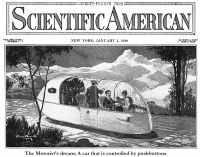 Figure 1: Streamline transport
Figure 1: Streamline transport
By the end of World War I, aircraft designers had already recognized the critical importance of aerodynamic design for reducing drag. Locomotive and automobile designers saw its virtues as well, and adopted the term. Many early industrial stylists were happy to adopt the word streamlining because it expressed modernism. We certainly all recognize that the word “streamlining” as applied to the design of static objects like radios, refrigerators, and clothes-irons is an oxymoron. But the term still persists today to describe any manufactured product with smooth compound forms using soft, sweeping, tapering curves.
There remains a general assumption that all of these “soft, smooth zippy forms” were adopted by the early crop of industrial designers as a result of arbitrarily borrowing forms derivative of aerodynamic design. A prominent example is this “streamlined” pencil sharpener by Raymond Loewy (fig.2). One of my jobs as the new apprentice at the Loewy office in 1942 was to make sure that all of Loewy’s pencils were honed to a needle-sharp point each morning. This sharpener, displayed prominently in his office, never went into production and frankly it didn't work Figure 2: Loewy Sharpener worth a damn. I used a trusty Boston sharpener instead. Ironically, this design has been hailed by design historians as a “quintessential iconic American design of the Streamline Era.” Even opining that “it doesn’t matter if it doesn’t do a good job of sharpening. In this case form trumps function.” Which, of course, is intellectual bullshit. The first job of a pencil sharpener is to sharpen pencils.
Figure 2: Loewy Sharpener worth a damn. I used a trusty Boston sharpener instead. Ironically, this design has been hailed by design historians as a “quintessential iconic American design of the Streamline Era.” Even opining that “it doesn’t matter if it doesn’t do a good job of sharpening. In this case form trumps function.” Which, of course, is intellectual bullshit. The first job of a pencil sharpener is to sharpen pencils.
When I had that chance to work at the Loewy office in 1942, there was still a strong emphasis on the illustration skills of the I.D. staff. Many presentations to clients consisted of impressively large color airbrush renderings, but there was also a growing emphasis now on the use of clay form-studies and full-size mockups to fully understand the form factors. To develop competent designs, it also became more and more incumbent on us to understand not only the advantages of newly introduced production machinery and materials, but also the constraints imposed as well.
As I’m s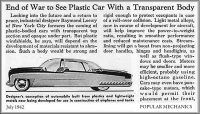 Figure 3: Post-war automobileure you know, Raymond Loewy was the consummate self-promoter. All design employees had to learn his distinctive signature and apply it to all our sketches and renderings. He employed a full-time publicist on his staff. Among my many chores at the Loewy office was handling the mailing of weekly promo publicity releases—including this release (Fig.3)—featuring a sketch of a “post-war” automobile with a full sunroof of clear plastic.
Figure 3: Post-war automobileure you know, Raymond Loewy was the consummate self-promoter. All design employees had to learn his distinctive signature and apply it to all our sketches and renderings. He employed a full-time publicist on his staff. Among my many chores at the Loewy office was handling the mailing of weekly promo publicity releases—including this release (Fig.3)—featuring a sketch of a “post-war” automobile with a full sunroof of clear plastic.
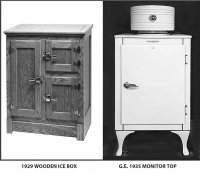 Figure 4: Traditional verses modern refrigerator
Figure 4: Traditional verses modern refrigerator
We were seeing a significant shift away from traditional fabrication methods for consumer products—take electric refrigeration as an example. Until the early 1930s, most homes, like mine, depended on block-ice, stowed in insulated wooden chests. Much of that wooden-chest fabrication method carried over into the new steel “ice-boxes.” All of the newly introduced major brand electric refrigerators employed traditional brake-formed sheet steel wrapped around an inner structural frame (fig.4).
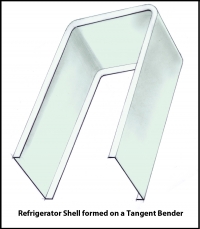 Figure 5 Tangent Bender
Figure 5 Tangent Bender
But clever new machines were coming on line. One such innovation was the tangent bender, that permitted radii to be formed by stretching brake-formed strip steel C-channels over simple male mandrels. Tangent bending allowed the outer shell, both sides and top, of a refrigerator to be formed as a single U-shaped piece. The outer shell now became the structural frame as well, totally doing away with the need for an internal box-frame (fig.5) This innovation was a real production-time saver and, more importantly, a critical cost-saver.
What’s important to note is that these new technologies and machines were not just influencing form design—they were often determining the limits or constraints of the forms. The minimum size of the radius produced on a tangent bender, before the steel would wrinkle, was approximately 3.5 inches. That determined that corner bends must necessarily have large soft radii. Additionally, the front, back, floor of the refrigerator, as well as its doors, were now being formed by hydraulic die-stamping, requiring compound planes to keep the thin steel surfaces from “oil-canning.” Thus we saw many appliances adopting soft-radii forms like this 1935 Sears Coldspot, (fig,6.) dictated by the machines of mass production—not necessarily by the whim, or brilliance, of the designers.
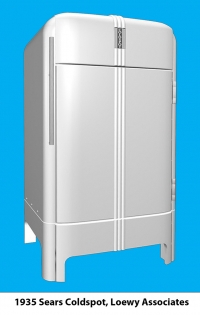 Figure 6: Sears ColdspotAs the development of new electric refrigerators and kitchen ranges ramped up after the close of World War II, cost-saving became a major goal in reducing manufacturing costs and increasing volume production. Refrigerator sales increased dramatically. Some traditional fabrication manufacturers fell by the wayside. Only factories that could afford the increasingly large upfront cost of massive stamping dies and presses were the ones able to make the huge leaps in production volume. Which in turn brought down the sales price to consumers, which is what mass-production is primarily about.
Figure 6: Sears ColdspotAs the development of new electric refrigerators and kitchen ranges ramped up after the close of World War II, cost-saving became a major goal in reducing manufacturing costs and increasing volume production. Refrigerator sales increased dramatically. Some traditional fabrication manufacturers fell by the wayside. Only factories that could afford the increasingly large upfront cost of massive stamping dies and presses were the ones able to make the huge leaps in production volume. Which in turn brought down the sales price to consumers, which is what mass-production is primarily about.
One of the early streamlined trains of that era was an articulated three-car commuter train called The Comet (fig.7), built by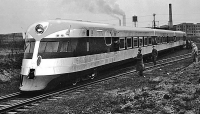 Figure 7: The Comet the Goodyear Zeppelin Company and Westinghouse for the New Haven Railroad. It ran between Providence and Boston. It was designed in 1935 by Donald Dohner, a year before he formed the Industrial Design Department at Pratt Institute. The Comet was not only aerodynamic, but light in weight because it used aluminum framing and shrouding. Even the underbellies were fully-shrouded for aerodynamic efficiency. But also note those projecting rivets.
Figure 7: The Comet the Goodyear Zeppelin Company and Westinghouse for the New Haven Railroad. It ran between Providence and Boston. It was designed in 1935 by Donald Dohner, a year before he formed the Industrial Design Department at Pratt Institute. The Comet was not only aerodynamic, but light in weight because it used aluminum framing and shrouding. Even the underbellies were fully-shrouded for aerodynamic efficiency. But also note those projecting rivets.
Surely Dohner would have preferred to eliminate those drag-producing rivet heads. Within just a few months, Howard Hughes set a cross-country speed-record in his H-1 Racer monoplane—one of the first to employ machined, countersunk flush rivets in its wings, fuselage, and empennage to reduce drag. Other new fabrication technologies appeared in quick succession. TIG aluminum welding for structural aluminum was introduced in 1941, and gas shielded metal arc welding (MIG) was perfected in 1948.
In 1934 the introduction of the new, speed-record breaking, stainless-steel Burlington Zephyr locomotive and train wowed the public and immediately garnered the name of “Streamliner.” But, it could not have used those smooth drag-reducing welded body shells until the E. G. Budd Company had devised a method for shot-welding stainless. Incidentally, that new speed record wasn’t solely due to aerodynamic streamlining. The Zephyr’s could not have achieved those astonishing speeds without the simultaneous perfection of the diesel-electric engine for rail locomotion—design as evolution.
The emergence of new metal alloys was also beginning to influence production methods. Steel alloys were being developed that were stronger, lighter, and allowed deeper draws. Similarly, high-volume die-casting tooling required soft, compound forms with generous draft, that helps speed the flow of the molten metal within the mold, minimizing stress lines and maximizing quick ejection from the mold.
Synthetic plastic choices were very limited, primarily urea and phenolics and a new clear acrylic resin called Lucite. Bakelite, which had formerly been restricted to electrical and military applications was, now starting to be used in mass-produced consumer products such as cameras, telephone handsets and table-radio shells, employing compression thermoset molding. In the late 1940s, the first commercial thermoplastic screw-injection machines were introduced, along with new polymers that opened up a vast new world of mass-produced form possibilities.
Finally, I would li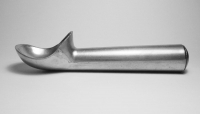 Figure 8: Ice cream scoopke to offer this handsome, die cast-aluminum ice cream scoop designed by Sherman Kelly in 1935 (fig.8). It has proven to be timeless in its ergonomic perfection. From solely an appearance standpoint, would you call this design “streamlined,” merely because it has a soft, sleek, shiny rounded aerodynamic look? No, its form was dictated almost 100 percent by its function and production tooling method.
Figure 8: Ice cream scoopke to offer this handsome, die cast-aluminum ice cream scoop designed by Sherman Kelly in 1935 (fig.8). It has proven to be timeless in its ergonomic perfection. From solely an appearance standpoint, would you call this design “streamlined,” merely because it has a soft, sleek, shiny rounded aerodynamic look? No, its form was dictated almost 100 percent by its function and production tooling method.
In summation, it was not only the talents of early industrial designers that manifested a strong influence on the attractive shapes and forms of static products for the masses during the “Streamline Era”. Those form factors also were influenced, and often dictated by, concurrent advances in new machinery, new methods, new systems, and new materials for the mass-production of goods.
You can see that this period was particularly exciting for young designers like myself—because those early “visions of the future,” that excited us as kids, were now starting to come to full realization.
Sources:
Figure 1: Scientific American January 5, 1918
Figure 2: 3-D Computer model of Loewy Pencil Sharpener created by Will Lidwell
Figure 3: Popular Mechanics. July 1942
Figure 4: Illustration created by J. Budd Steinhilber based upon existing images
Figure 5: C-Shell illustration created by J. Budd Steinhilber, FIDSA
Figure 6: 3-D Computer model of the Sears Coldspot created by Will Lidwell
Figure 7: The image of the The Comet is from the Denver Public Library.
Figure 8: Ice cream scoop photographed by J. Budd Steinhilber, FIDSA